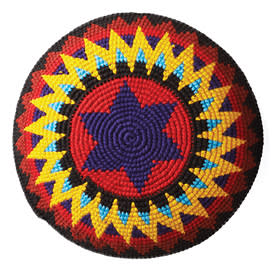For the past two generations, it has become customary for Modern Orthodox men to wear garishly decorated knitted kipot, instead of plain fabric skullcaps as previously customary. Let us examine the meaning of this remarkable custom.
The most prominent source legitimating this type of headgear is in the Shulchan Arukh (OC 91:4): “Hats which are woven from straw are considered a [head] covering” despite the many openings. The same applies to knitted yarmulkes.
The source for the Shulchan Arukh is in turn Trumat HaDeshen, responsum 10. Truman HaDeshen proves that woven coverings are acceptable based on the gemara which concludes that wearing a basket fulfills the Torah requirement for married women’s head covering though not the additional requirement of “dat yehudit” (literally, “Jewish religion”) (Ketubot 72a-b).
This source suggests several reasons why this type of head covering became customary specifically among the Modern Orthodox:
- The open weave of a basket is an appropriate symbol for a community that prides itself on its open-minded approach
- The fact that a basket-like head covering is identified with Torah but not with “dat” makes it particularly suitable for a community which declares allegiance to Torah but likes to emphasize that Judaism is a culture, a civilization, a philosophy, a nation, etc. not just a “religion”
- Headware reminiscent of a basket naturally reminds us of basket ball, a sport which is particularly popular among the Modern Orthodox (even since the departure of Red Sarachek from YU).
The association with baskets illuminates one final characteristic of knitted kipot – the custom to embellish them with various garish designs.
The mishna at the end of the fourth chapter of Bava Metzia explains that it is impermissible to decorate old utensils to make them appear new, but the gemara adds that if they are already new it is permissible. Among the isolated examples we learn that it is permissible “litzlumei dikulei”, literally “to decorate baskets”. The choice of this example suggests that baskets are particularly appropriate objects of decoration; Trumat HaDeshen’s identification of loosely woven headgear with baskets automatically suggests that we should make such a head covering brightly ornamented.
Rabbi Asher Meir is the author of the book Meaning in Mitzvot, distributed by Feldheim. The book provides insights into the inner meaning of our daily practices, following the order of the 221 chapters of the Kitzur Shulchan Arukh.
The words of this author reflect his/her own opinions and do not necessarily represent the official position of the Orthodox Union.
